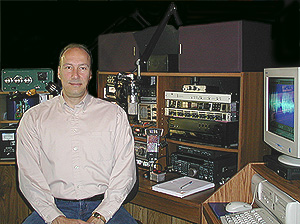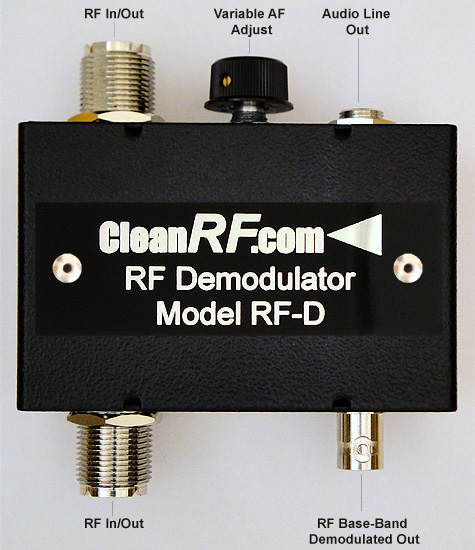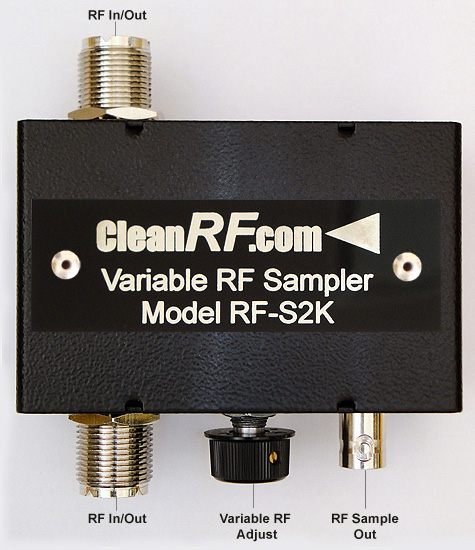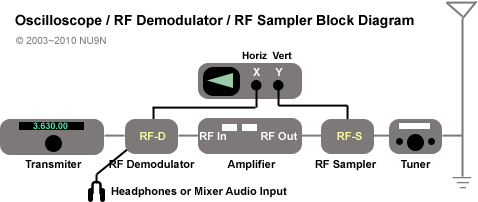2 - Calibrating Oscilloscope and Power Output for Envelope Mode:
Tune up your exciter (transmitter) if necessary, and then your amplifier to its rated output within legal limit operation (1500w PEP). (The linearity tests discussed later in "Application 3" will determine if you tuned your
amplifier properly)
With a continuous carrier established at the desired power level, adjust the "Vertical (Y) Voltage Gain" control on your oscilloscope so that the centered horizontal sweep trace expands 2 divisions above and below the baseline
established in "Figure 2" on the oscilloscope's display. You should be able to make this adjustment within 10 seconds. Calibration is now complete and you can proceed to the mode you will be using (SSB or AM). See "Figure
3" below.
Figure 3

Oscilloscope Calibrated for Full Carrier Power Used
SSB Modulation Envelope Pattern:
When using the SSB or AM modes, adjust your audio gain so that your RF envelope peaks expand to the established plus and minus 2 divisions previously calibrated for, shown in "Figure 3". A well modulated SSB modulation envelope
will look like "Figure 4" and an overmodulated SSB pattern is also represented in "Figure 5", both shown below.
Figure 4

Proper SSB Voice Envelope Pattern at Full Modulation / Drive Power
Figure 5

Incorrect SSB Voice Envelope Pattern Showing Overmodulation / Drive Power
AM Modulation Envelope Pattern:
When using AM, first calibrate an unmodulated carrier to the plus and minus 1 division level shown in "Figure 6". To achieve a fully 100% modulated envelope, adjust your audio gain so that the envelopes expand 2 divisions above
and below the baseline. See "Figure 8" below. This would indicate full PEP modulation at 4 times the unmodulated carrier level. See "Figures 6, 7, 8, 9a and 9b" below.
Figure 6

AM Unmodulated Carrier Calibration
Figure 7

Undermodulated AM Envelope
Figure 8

100% Modulated Symmetrical AM Envelope
Figure 9a

Overmodulated "Low-Level" AM Envelope (Balanced Modulator)
Figure 9b
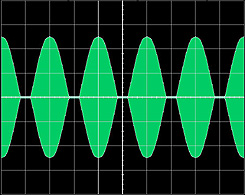
Overmodulated "High-Level" AM Envelope (Plate Modulation)
Figure 9c

AM Asymmetry - Correct Phase (Pos 110%, Neg 95%)
Figure 9d
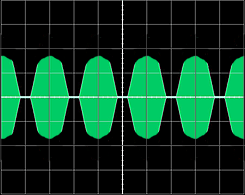
AM Asymmetry - Inncorect Phase (Pos 95%, Neg 110%)
APPLICATION #2
Using Your Oscilloscope as an Instantaneous Peak Reading Power Meter:
Using the outlined techniques so far, you also have an excellent instantaneous peak reading power meter. If, for example, your initial adjustment on your oscilloscope was relatively based on 500 watts (measured with an existing in line
meter) at the plus and minus 2 division marks on your oscilloscope, then the SSB or AM modulation envelope, as observed above, will be exactly 500 watts PEP whenever the peaks reach these divisions or any relative power level observed
and set with this method.
This same method can be used with trapezoid linearity monitoring as well.
Refer to "Application 3" below.
APPLICATION #3
Trapezoidal Pattern Linearity Signal Monitor System Self Diagnostic Test:
With this method, two sources will be used to feed both the Horizontal (X) and Vertical (Y) inputs of the oscilloscope, simultaneously comparing the output signal of the transmitter with the output signal of the linear amplifier.
!!!WARNING: THE MODEL RF-D (RF DEMODULATOR) MUST BE CONNECTED TO THE TRANSMITTER'S OUTPUT - NEVER TO THE AMPLIFIER'S OUTPUT. FAILURE TO COMPLY WILL DESTROY THE DEMODULATOR
AND VOID YOUR WARRANTY!!!
At this time, set your oscilloscope controls as follows:
Set oscilloscope to "XY" mode. (No horizontal sweep, small focused dot will appear - See "Note 3" below)
Most oscilloscopes will have an "XY" button. Others may provide the "XY mode" via the "A and B Sec/Div" knob. Some older oscilloscopes will not have an "XY mode" selection at all because the "X"
input is the "External Horizontal Sync" input. When this is the case, simply select the "External" position on the oscilloscope's "Sweep Range" selector.
Vertical voltage scale 2v / Div for starters. - See "Note 3" below.
Both Horizontal (X) and Vertical (Y) channel coupling selectors to "DC" coupling.
Note 3: Move the focused "dot" to the far left side of the screen, then while applying voice or data modulation, adjust the voltage selection controls so that the trapezoidal pattern
fills half of the screen horizontally, and plus / minus two divisions vertically.
The Horizontal (X) input of the oscilloscope will be fed by the model RF-D (RF Demodulator) via the transmitter.
The Vertical (Y) input of the oscilloscope will be fed by the series RF-S (Variable RF Sampler) via the linear amplifier.
System Self Diagnostic Test:
With your amplifier turned off or in stand by, transmit voice or data and check to see that produced is a perfect trapezoidal pattern. This is a self diagnostic test, and you must see a perfect trapezoidal pattern as you are comparing
the original signal to itself. If the trapezoid looks like "Figure 10" below, then you are ready to turn your amplifier on and in the operating position to check for its linearity. If you did not produce a perfect trapezoid
with the amplifier in the off or standby position, then you should contact me directly.
Adjustment of voltage scale will be required to achieve resolution - See "Note 3" above.
If your amplifier is linear, the oscilloscope pattern will look like a near perfect trapezoid (Sideways Elongated Triangle) with sharp and distinct angles during voice or data transmissions. See "Figure 10" below.
Figure 10

Linear Trapezoid Modulation Pattern
If your amplifier has a linearity issue, the trapezoid's widest end, opposite the point, will be flattened on the ends, or some other property of the trapezoid will be distorted with a lack of distinct angles.
See "Figures 11, 12 and 13" below.
Figure 11

Nonlinear Trapezoid Modulation Pattern
Figure 12

Nonlinear Trapezoid Modulation Pattern
Figure 13

Nonlinear Trapezoid Modulation Pattern
More often than not, a nonlinear trapezoidal pattern is the result of a mistuned amplifier, particularly with the load control being set with insufficient loading. To test this, simply advance the load control slightly.
With more loading of the amplifier, you will more than likely see the widest side of the trapezoid edges become nice and crisp as seen in "Figure 10" above.
If the resulting patterns displayed on the oscilloscope are well formed, your unintelligible distortion products will be significantly reduced, resulting in a one to one ratio between your audio frequency and radio frequency bandwidth.
This is a step in the right direction and is more than most hams ever attempt to do in analyzing their on-air signal purity.
Conclusion
Even though these scope measuring techniques will not be as complete in determining IMD, THD and more complex forms of distortion as a true RF Spectrum analyzer, if the resulting patterns displayed on the scope are well formed, your distortion
products will more than likely be well within FCC specs and guidelines for good engineering practice. It is a step in the right direction in solving common distortion problems and is more than most hams ever attempt to do in analyzing
their on-air signal purity.
Have fun, and may you find "Scoping Out Your Audio" to get the full scope of things as rewarding and educational as I have...
73,
John Anning, N U 9 N



